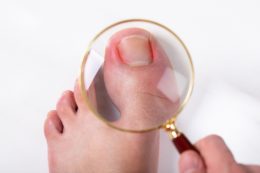Filed under Ingrown Toenail …
All About Preventing and Treating Infected Ingrown Toenails
Infected ingrown toenails can cause great pain and discomfort. For some, walking may prove difficult as a result of experiencing this condition. Fortunately, both preventing and treating ingrown toenails are possible.
What Causes Ingrown Toenails?
Grooming
According to the American Academy of Orthopaedic Surgeons (AAOS), an ingrown toenail is most commonly caused by trimming your nails too close to the curvature of your toe. This will cause the nail to instead grow into the flesh and create inflammation and potential infection. Most often, this condition will affect the big toe.
Ill-Fitting Footwear
Ingrown toenails can also be caused by wearing shoes that are too narrow or short. Footwear that is too snug can place excessive pressure on the nail and cause it to grow inward.
Congenital Causes
In some cases, the cause of ingrown toenails is congenital. The nail grows too large for the toe and instead goes inward.
Chronic Condition
Patients with ingrown toenails may also develop a chronic condition where the nail continues to grow inward. This will usually require some type of medical intervention to correct the natural growth of the nail itself.
What Are the Symptoms of an Ingrown Toenail?
The AAOS states the following are common symptoms of ingrown toenails:
Early stages:
- Hardness
- Swelling
- Tenderness
Later stages:
- Redness
- Infection
- Increased soreness
In some cases, an infected ingrown toenail may also cause pus to drain from the area as well. If you notice a discharge coming from around your toenail, you should visit a podiatrist immediately for treatment.
How to Prevent Ingrown Toenails
In some hereditary cases, preventing ingrown toenails may be ultimately unavoidable and require intervention from a medical provider. However, some common ways to prevent ingrown nails include:
Choose Proper Footwear
Do not wear shoes or socks that fit tightly. This will create excess pressure on the foot and can push nails inward. Your shoes should always have enough room for you to move your toes with no discomfort.
Careful Grooming
Clipping a toenail too closely is a major contributing factor to ingrown toenails. Clip no more than absolutely necessary and avoid cutting too closely into the corners of the nail. It is always best to cut the nail evenly across.
Avoid Causing Trauma to the Foot
No one wants to drop a heavy object on their foot, but accidents do happen. Handle heavy objects carefully and always place them down, if able, should you need to rest. If you work jobs that require you to handle heavy or sharp equipment, wear protective footing like steel-toed boots to provide extra protection.
If Recurring, See a Podiatrist
If you are dealing with recurring ingrown toenails, you should see a podiatrist for preventative treatment. They can offer a variety of options to help treat the condition and promote healthier nail growth.
Treatments for Ingrown Toenails
Whether infected or not, there are both surgical and nonsurgical treatment options available for those living with ingrown toenails. A podiatrist will determine the best possible treatment for your toe after an initial examination.
Some treatment options include:
Medical Intervention
If the ingrown toenail has become infected or develops into a chronic condition, a podiatrist will likely recommend medical intervention. Some medical treatments for ingrown toenails include:
- Lifting the nail – usually done if the nail has not become infected.
- Removing part of the nail – the podiatrist will often numb this part of the toe beforehand
Option 3: Removing Part of the Nail and Tissue Permanently
For chronic conditions, the doctor may recommend removing part of the toenail and its underlying tissue in the area where the condition is present. This may involve a chemical, laser treatment, or another method. By removing part of the nail bed, it will prevent the ingrown portion of the toenail from repeatedly growing inward. This may also change the appearance of the toe.
At-Home Self-Treatments
Not all cases of ingrown toenails will require medical attention. Some at-home treatments for ingrown toenails include:
- Soaking the affected toe(s) in warm water up to 4 times a day for 15-20 minutes at a time.
- Wearing more comfortable shoes to prevent discomfort and re-aggravating the condition
Need Help for Your Infected Ingrown Toenail? Don’t Wait
If you have an ingrown toenail, infected or not, and would like a medical opinion, don’t wait to hesitate to speak to your podiatrist. They can help advise you on the best possible treatment and provide a medical intervention if necessary.
Do you live in the Delaware area? If so, we can help treat your ingrown toenail ourselves. Contact us anytime to request an appointment.






